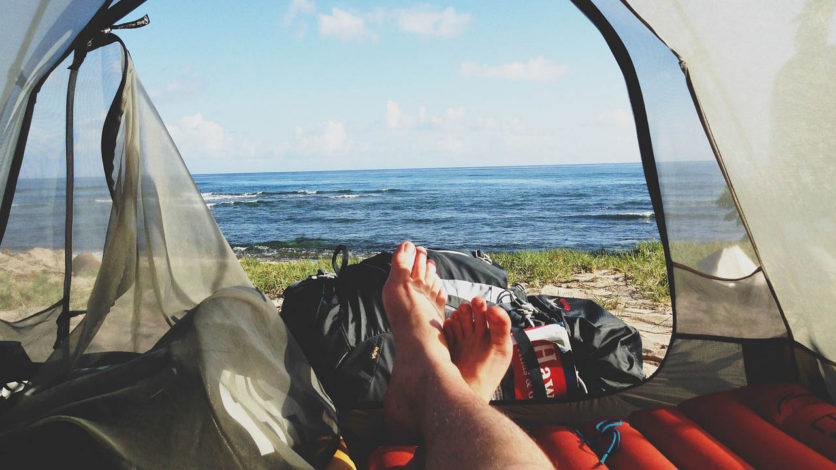Your tent is often your primary form of shelter when out on a trip as well as being one of the more expensive items of outdoor equipment so it makes sense to take care of it.
A good quality tent should last for years without too much attention but here’s some handy tips to help you extend the life of your tent and keep it in service for as long as possible.
Tip #1: Choose a site carefully
Look for a sheltered campsite with little to no vegetation as this will leave the smallest impact on the environment. Always try to minimise the impact you have on an area especially when wild camping. That means leaving any site as you found it.
Check carefully before you place your tent that there is no debris underneath it. Sharp twigs, pine cones and rocks can abrade the bottom of your tent as well as being quite uncomfortable to lie on.
I usually test the ground by laying down where I’m likely to be sleeping to check for anything that might be on the ground. It also helps to identify if you are going to be sleeping on a slope. While that won’t affect your tent, it could make for an uncomfortable night.
Make sure that you choose a dry, sheltered spot for pitching your tent. Running water underneath you isn’t going to be pleasant but a strong wind could be disastrous and potentially damage your tent.
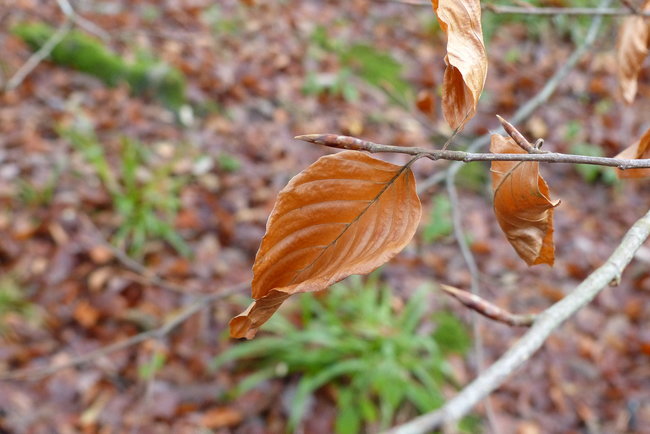
Avoid pitching your tent under any tree limbs, especially Beech.
If you are camping in a woodland then take a look above you as well as below. Look out for any overhanging branches which could fall on you. Beech (Fagus sylvatica) is one you really want to avoid camping under as it’s well known for shedding limbs especially in windy conditions, hence its nickname, the widowmaker. Here’s a guide if you’re not sure how to identify it.
[bctt tweet=”Avoid camping under beech trees as they regularly shed their limbs.”]Tip #2: Use a footprint
A tent footprint is a custom made groundsheet designed to lie underneath the tent floor. It gives an extra layer of protection from any sharp objects on the ground that might puncture your tent. If you’ve selected a good place to pitch then this shouldn’t be a problem but it can give some peace of mind all the same.
A footprint can stop water pooling underneath your tent as well if you’ve had to pitch in a less than ideal location. Just make sure that the footprint remains underneath the tent and doesn’t poke out from the side. Doing so can have the opposite effect, allowing water to collect between the footprint and the tent floor.
Footprints can be expensive for what they are and it’s possible to make your own groundsheet for a lot less money. If you’re looking to save weight then Tyvek is a good material choice often used by lightweight backpackers. It’s not fully waterproof but is very light and can give some added protection to your tent.
Tip #3: Treat the zippers with care
Zips are generally a weak point of any tent. They can snag or break especially if you don’t treat them well. Some lightweight cottage manufacturers don’t use zips at all for exactly this reason. It’s one less thing to break.
It’s important that you maintain them well and that means keeping them free of any dirt or grit. While you’re using it that could just mean giving your tent a shake to get rid of any loose material but when you get it home it’s best to go over it with clean water.
Don’t force a zipper to open or close as this puts a lot of stress on it. You’ll often find a lot of tension on the zips which is normal as the tent is supposed to be pitched as taut as possible. Using two hands instead of one is a good idea. One hand can relieve the tension while the other pulls on the zip.
There are various zipper lubes available but the best thing is to just make sure that they are kept clean and free from dirt. Don’t try to use any petroleum based lubricants such as Vaseline.
Tip #4: Don’t wear your footwear inside
Leave your shoes or boots outside your tent before you get in. Most tents have some kind of vestibule to store items such as your boots and backpack to stop you introducing dirt into your tent.
Tip #5: Keep heat sources away from the fabric
If you’re having a campfire make sure to build it well away from your tent to avoid sparks and embers coming into contact with the fabric. Neither synthetic or cotton tents like fire. In the best case scenario you’ll be left with a nasty mark, in the worst case it could burn your tent down.
The same goes for using a camp stove. I have and do use a stove in my tent vestibule at times but I make sure that the stove is as far away from the fabric as possible.
[bctt tweet=”If you’re going to use a stove in your tent vestibule, keep it away from the fabric.”]Using candles or gas lanterns inside your tent can also be hazardous. I prefer the light of a flickering candle to that of an LED bulb which I find quite harsh. If I’m camping light then I’ll take a head torch but in the winter I like to use a tipi and a candle lantern for light.
If you’re going to do this make sure you keep the flame away from the edge of the tent and check that it’s not getting too hot. For your own safety always make sure there is sufficient ventilation to avoid carbon monoxide poisoning.
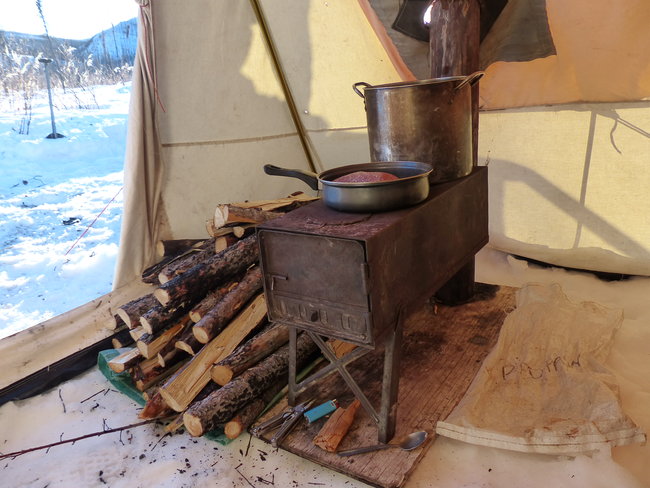
Hot tenting can be a great way to get outside in winter but make sure that you use a tent that it designed to accommodate a wood burning stove.
If you like to hot tent like I do in the winter then make sure that your tent is designed for the job. If you’re unfamiliar with hot tenting, it’s where you use a wood burning stove with a chimney to heat the tent. It’s a fantastic way to be out in the winter but the hazards are obvious.
If you are using any kind of heat source inside your tent make sure to carry a knife with you in case you have to cut yourself out of the tent in an emergency.
Here’s a great article if you want to learn more about how to live in a heated tent.
Tip #6: Avoid extended ultraviolet exposure
UV rays are a silent killer for nylon and polyester tents. Even cotton canvas tents will be affected by UV radiation if left out for long enough though are much more resilient. The effect of prolonged exposure is a breakdown in the fibres making them brittle and dry. This reduces the strength of the fabric making it far more likely to tear.
This doesn’t mean that you shouldn’t pitch it in the sun, just make sure that you don’t leave it up for days on end. Most tent fabrics have a UV treatment applied to them to give them extra protection but you will want to renew this regularly with a product like Nikwax SolarProof.
Tip #7: Bring a repair kit
Most tent manufacturers now include a small repair kit when you buy the tent. Typically these include small fabric patches for repairing any holes as well as pole splints to repair a tent pole in the field.
Duct tape is another handy addition to add to any repair kit as it will allow you to deal with a multitude of repairs at least as a temporary solution.
Tip #8: Look after your tent poles
When assembling your tent poles always make sure that you do it in a controlled way rather than letting them ‘snap’ into place by themselves. While this may take fractionally longer, it will extend the life of your poles by avoiding any chipping which could weaken them.
For disassembly, separate the poles somewhere in the centre first to release the tension from the shockcord. Also avoid flailing the poles around as you could chip them on the ground or a nearby tree.
Tip #9: Don’t use chemical agents like insect repellent near the fabric
Chemical agents such as insect repellent can break down the tent fabric and weaken it, or burn through it in a worse case scenario. DEET is incredibly powerful and you should take care when applying it to keep it away from your tent (or any synthetic fabrics).
Tip #10: Keep your tent clean and reproofed
Obviously your tent is designed to be used outdoors so it shouldn’t require constant cleaning. If it’s looking dirty or starts to smell then it is going to need a thorough clean but other than that a quick rinse under the garden hose should do the trick.
If you’re out on the trail then just try to wipe down any dirt as you notice it and keep it as clean as you can. I usually brush out any loose dirt from the inner tent when I’m packing it away in the morning so that it’s clean when I set it up up again later that day.
When you need to clean it more thoroughly then hand wash it using a non abrasive cloth or sponge with cold or warm water (but not hot) and a non detergent soap. Something like Nikwax Tech Wash is ideal which will also revitalise the DWR (durable water repellency) treatment of your tent fabric. Once you’ve cleaned it, let it dry naturally in a shaded area.
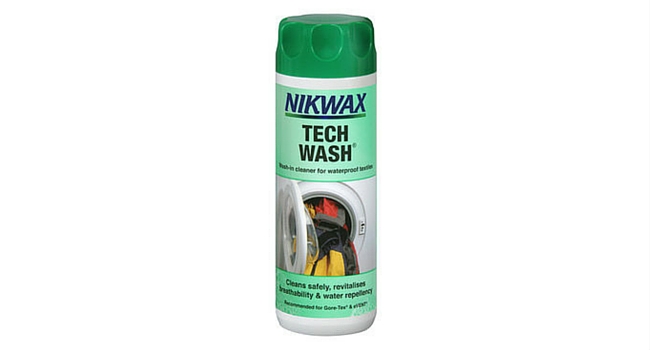
Nikwax Tech Wash will clean and revitalise any DWR treatment on your tent fabric.
It’s also a good opportunity to check for any damage or wear that’s been caused to the tent so that you can make any necessary repairs as quickly as possible to prevent it getting worse.
Don’t use any household cleaners that are perfumed in any way as this could attract animals and bugs to your tent which you don’t want.
Never put it in the washing machine or a tumble drier. Putting it in the washing machine could snag the fabric or trap a zip as it thrashes around in the machine causing damage and the heat of the tumble drier could melt the material.
[bctt tweet=”Never put your tent in the washing machine to clean it.”]Tip #11: Don’t store it wet
Packing your tent away wet is one of the worst things you can do as mildew will form and break down the fabric over time. That’s why it’s essential to make sure that you dry it completely before putting it into any long term storage. Ensure the poles are also dried completely to avoid any buildup of corrosion.
As mildew forms it starts to smell and small spots will appear on the tent fabric. As the fungus reproduces it will split the fabric from its protective coating causing a breakdown of the waterproofing properties and eventually a complete degradation of the fabric itself.
When you’re using the tent on a trip it may be harder to keep it completely dry. If it’s not raining in the morning I try and give it a chance to dry naturally while I have breakfast and pack everything else away. You can also use a small camp towel to wipe off any remaining condensation before packing it away for the day.
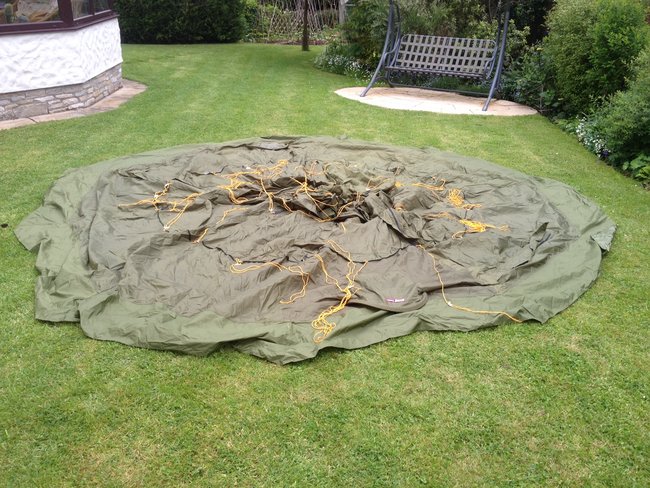
Dry your tent out completely when you get home to avoid any buildup of mildew.
I always keep a spare dry bag for the inner tent for times when I have to pack the flysheet away wet. That stops the inner getting wet as well.
Sometime it’s just not possible to pack it away dry as it might be raining when you break camp. In that case try and air it during the day or in the evening when you make camp again.
[bctt tweet=”Never store your tent wet. Keep it loosely in a large, breathable bag.”]The best way to store your tent between trips is loosely in a large, breathable bag, somewhere shaded and dry. Don’t put it in a damp loft space as that will invite mildew as well. Don’t store it compressed for any period of time either as that will weaken the fabric.
Bonus Tip: Don’t fold it the same way every time
If you always fold the fabric the same way as you’re packing it away you will weaken the tent fabric along the crease lines over time and reduce the waterproofing. Instead, just ‘stuff’ the tent back into its sack randomly. It’s also usually easier and quicker to get the tent away using this method.
Do you have any other tips to care for your tent both in the field and at home?
Share this Post

